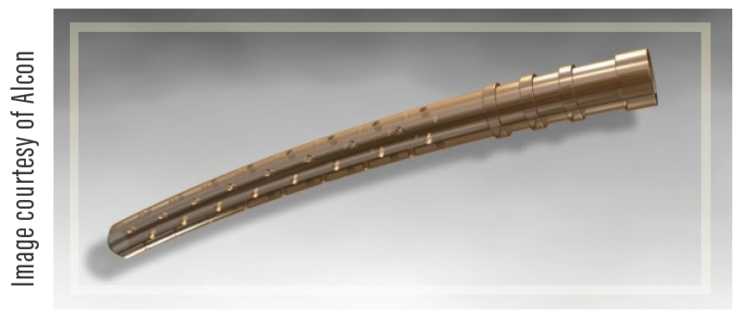While topical therapy will undoubtedly continue to play an important role in glaucoma management, surgical procedures are becoming increasingly important for patients who either cannot be managed on drops or who require additional management options. Yet, because of the emergence of microinvasive glaucoma surgery (MIGS) devices, surgery does not necessarily have to be restricted to the most severe manifestations. Instead, the more favorable safety profile of MIGS makes them an appropriate choice for cases with mild to moderate primary open-angle glaucoma.
The MIGS category is continuing to grow. Newer entrants to the MIGS category, however, are not mere “me too” devices; instead, devices such as the CyPass Micro-Stent (Alcon) target non-trabecular meshwork to improve physiologic outflow. Fundamentally, these new offerings provide more options for patients undergoing a combined glaucoma and cataract procedure and a greater ability to tailor the approach to surgical management, according to Steven Vold, MD, who is in private practice at Vold Vision in Fayetteville, Ark.
supraciliary Approaches: Role and Rationale
The microstent is implanted in the supraciliary space (Figure) through an ab interno approach at the time of cataract surgery using the same corneal incision. The device avoids the trabecular meshwork (TM) and Schlemm canal, instead effecting aqueous egress via uveoscleral outflow. “The fundamental principle of the CyPass is that drainage to the superciliary space occurs because of a negative pressure gradient relative to the anterior chamber, which theoretically might yield greater magnitude of outflow—and larger reductions in IOP,” he says. “Yet, the surgery spares the conjunctiva and is associated with a more favorable safety profile than incisional techniques. As a result, placement of the CyPass does not preclude the ability to perform filtration surgery should that option be necessary in the future.”

FIGURE . The microstent is designed to be implanted in the supraciliary space.
Dr. Vold served as an investigator in the COMPASS pivotal trial that led to the CyPass gaining approval for use in individuals with mild to moderate glaucoma at the time of cataract surgery. In this multicenter, investigational study, 505 patients were enrolled, with 374 receiving the CyPass at the time of cataract surgery, and 131 undergoing cataract surgery alone.1 Unlike previous studies involving MIGS devices, COMPASS utilized a medication washout prior to randomization, which permitted an assessment of IOP lowering efficacy independent of a potentially important confounding factor. Overall, screening and baseline characteristics were balanced between the two groups, and there were more whites (83.6%) and women (53%) enrolled.
The study’s primary efficacy endpoint was met, with 72.5% in the microstent group and 58.0% in the control group achieving a clinically significant decrease in unmedicated mean diurnal IOP from baseline to 24 months
(P = .0011). Furthermore, in the microstent and control groups, the unmedicated mean diurnal IOP from baseline to 24 months was reduced 7.0±4.5 and 5.3±4.0 mm, respectively (P < .0001), and percentage of patients with an unmedicated diurnal IOP between 6 and 18 mm Hg at 24 months was 61.2% and 43.5%, respectively (P = .0001).
Implications for Patient Management
Dr. Vold says the expansion of the MIGS class has changed the way he is able to individualize the approach to glaucoma management. This is a central tenet of medical management, where treatment is directed to controlling pressure while considering the safety, efficacy, and convenience of the approach. Additional MIGS options on the market, including this device, allow for a discussion on custom glaucoma surgery with patients, wherein the approach can be adjusted based on the type of glaucoma, the stage of glaucoma, and the health of the eye.
“In the future, I will be interested to see how the various MIGS devices may be complementary, and if, in fact, we can perform these procedures as standalone operations, either as a singular approach, or in conjunction with other MIGS devices. The era of individualized approaches to glaucoma management is truly upon us, to the great benefit of our patients,” Vold says.
1. Vold S, Ahmed II, Craven ER, et al; CyPass Study Group. Two-year COMPASS trial results: supraciliary microstenting with phacoemulsification in patients with open-angle glaucoma and cataracts. Ophthalmology. 2016;123(10):2103-2211.
Dr. Vold serves as a consultant for Alcon.


